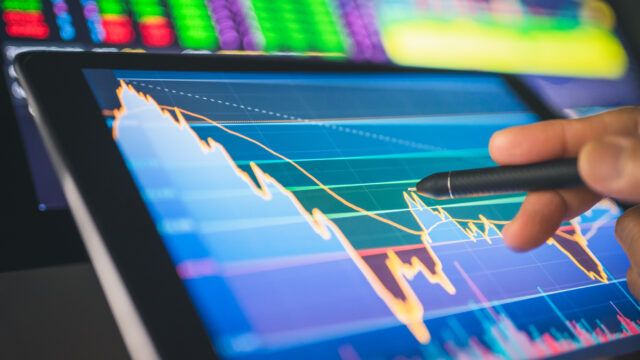Watch the full interview below
Interview transcript
How should we make sense of this year’s volatility?

Song Sheng: I think volatility is a natural part of the global financial landscape and staying informed and cautious can actually help investors to navigate these fluctuations. The first half of 2023 has been very volatile, yet a very strong one for equity markets. Investors have had to ride through a banking crisis, the possibility of recession, US debt ceiling issues, sticky inflation, geopolitical uncertainty, to name just a few. And yet, despite all these issues, all the major stock markets actually recorded positive returns, led by the US market and in particular the mega-cap stocks.
And in our view, the strong performance in equity markets rest on two key pillars. First is disinflation and a soft lending in the US economy. In many developed economies, inflation actually peaked around middle to end of 2022 and has since come off from their highs. However, since the inflation data remains above their targets, major central banks continue to be in an inflation-fighting mode even though the global economy has slowed. We expect further disinflation due to downward pressures in both cost push as well as demand pull inflation.
And the second reason is the absence of a hard landing as the health of the economy impacts corporate earnings. In the US, for example, GDP growth, labour market, consumer spending and even housing demand have continued to hold up despite the Fed’s effort to tighten financial conditions. And I think recession worries are likely to carry over into the remaining part of the year and even into 2024.
While the banking crisis in March looks over, the issues of the smaller regional US banks remain. This comes from their exposure to the US commercial real estate sector and the high interest rate and high liquidity environment will continue to create headwinds for these smaller US banks. Also, the delayed effects of monetary tightening and tighter credit availability will still dampen economic growth. That said, due to the strong labour market which supported consumer spending, we have shifted our expectations of a mild US recession from the second half of 2023 over to 2024.
Where does China fit into 2023 investment strategies?

Song Sheng: This is a tough one. I think the optimism at the start of 2023 from China’s reopening has seemingly fizzled out with investors showing their displeasure via the weak performance in Chinese equities. The manufacturing and export sectors have been hit hard amid a global slowdown. Nevertheless, due to strong domestic consumption from reopening, I think China’s economic cyclical upturn is still intact and China is very likely to be able to meet its GDP growth target of around 5%.
Having said that, I think the hefty expectations have been tempered given China’s stimulus. Earlier this week, we also saw China’s top leaders pledge to adjust and optimise policies in a timely manner for its beleaguered property sector and the key pivot is the absence of housing is for living, not for speculation, a tagline which has been used since 2016 and the ensuing set of policy that crushed the industry.
China also vows solid measures to ensure employment stability, along with other pledges to boost domestic consumption demand and to resolve local debt risks, for example. Markets reacted positively but whether this rally is sustainable or not is very much dependent on whether we see some more concrete policies come up from the government.
Despite the underperformance in recent years, I think investing in China still offers diversification and huge growth potential. From a valuation perspective, Chinese stocks are trading at attractive levels, both compared to its own history as well as to the global markets. Personally, I think having an exposure in China markets still makes sense from a longer-term perspective, but one needs patience and convictions to reap the fruits from investing in China.
Does ESG remain as relevant despite a difficult past 18 months?

Song Sheng: I think in 2022, a lot of ESG funds actually underperformed, especially those that employ exclusion screening after dirty sectors like fossil fuel and natural resources actually outperformed. But I think ESG is here to stay and remains relevant and important. While there are debates on whether ESG actually contributes to positive impact in terms of long-term investment performance, I think ESG integration has proven to reduce portfolio risks, including reputation, political and regulatory risks, as ESG-focused companies often demonstrate sustainable business practices and a focus on long-term value creation.
And besides, new and updated global ESG-related regulations and standards also continue to evolve, including here in Singapore, and I think this will eventually influence how businesses and organisations approach ESG issues. At UOB Private Bank, we believe that as an investment adviser and manager, a deliberate incorporation of ESG factors into our investment decisions and recommendations will create long-term value to the client and contribute towards the sustainable development of the society.
We have integrated the assessment of material ESG risk into our investment process, including the appraisal of ESG impact on the company’s risk premium and fair value across the capital structure by using both proprietary methodologies and third-party ESG data. And besides, to better engage external managers, we have also developed an in-house ESG rating system to access the fund manager’s commitment and integrity of its ESG policies as part of our due diligence process. Seeing past the ESG label, we spend a lot of time on understanding how these managers integrate ESG into their investment universe, philosophy processes, as well as decision-making.
Is fixed income back and what does this mean for investors in Asia?

Song Sheng: I think fixed income has been an essential part of the asset allocation mix for Asian investors and will continue to be so. Fixed income has had a challenging year last year, but a lot of investors actually question whether this allocation still makes sense in their portfolios. However, following one of the worst years, bond yields have really seen a sharp uptick.
Currently, there is a lot of debate as to whether the Fed rate has hit its peak or there are a couple more hikes still to come. But it is worth noting that historically Fed rate cuts were front-loaded, with majority of the reduction being delivered within the first year. Hence, these conditions could be conducive to both attractive income generation as well as potential capital gains.
Our UOB macro team expects the Fed funds rate to stay at 5.5% for the rest of 2023, to be followed by rate cuts in 2024. I think investors should take this opportunity to lock in high yields and participate in the potential upside.
We still remain positive on IG credits for both developed market and emerging market, with the view to increase quality and extend duration. Given an anticipated rise in default rates due to growth slowdown, we stay underweight in DM high yield, but we are neutral on EM high yield and continue to advocate investors to stay highly selective and diversified.
The market for AT1 bonds had been frozen, following US banking failures and the Credit Suisse saga, which wiped out its $17bn AT1 bonds. But in June we saw two deals tapping the market, one of which was oversubscribed by 10 times, showing that investors are still receptive to AT1s if priced correctly. As for funds, some of the unconstrained bond funds that are able to exploit the best opportunities, either by having the flexibility with respect to the kind of fixed-income assets they can invest into or flexibility in adjusting its duration exposure, are currently on our fund focus list.
What role will alternatives play within a portfolio?

Song Sheng: Alternative investments, I think, are supplementary strategies to the traditional long only positions in stocks, bonds or cash. These investments often have risk characteristics that are very different from the traditional long only investments and they usually employ active management. Hence, alternatives provide not just an opportunity for portfolio risk diversification, but also a new source of alpha.
Alternative investments such as real estate and commodities have also historically acted as hedges against inflation and with the introduction of semi-liquid solutions, I think it might be a game changer as it helps to overcome some of the challenges of traditional lock-up vehicles and broaden investor inclusion. Instead of the patented plus one plus one lockup period, semi-liquid funds provide quarterly or even monthly liquidity, although often come with soft lock and subject to certain gate provisions.
Semi-liquid funds also allow investors to access these private markets with a lower commitment compared to traditional drawdown funds. Semi-liquid funds can offer immediate private market exposure and help to mitigate J-curve. Coupled with more launches of semi liquid solutions, I think these characteristics will eventually help to increase the penetration rate of alternative investments in the coming years. At UOB Private Bank, we have been ramping up our alternative solutions since 2017 and we prefer semi-liquid vehicles for the reasons mentioned earlier.




















